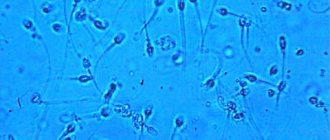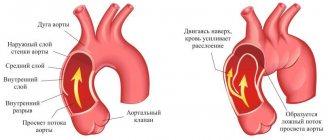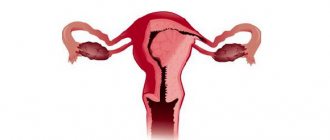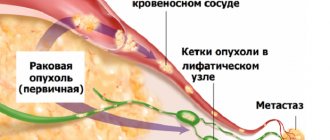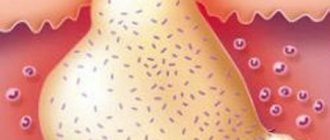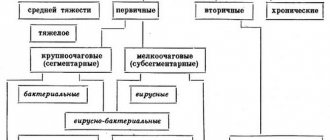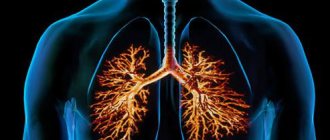What is mastoiditis and mastoid process of the temporal bone - definition of the disease
Mastoiditis is an infectious inflammatory process that occurs in the mastoid process of the temporal bone. The disease is often a complication of acute otitis media.
Inflammation is accompanied by increased body temperature, ear pain, intoxication, pain and swelling in the mastoid area. Mastoiditis can lead to hearing loss.
The course of inflammation depends on the structure of the mastoid process. In most cases, mastoiditis occurs in people who have large cells inside the appendix. Infection from the tympanic cavity penetrates there very easily.
Classification of mastoiditis:
- According to the site of infection:
- Primary (infection enters directly into the mastoid cavity).
- Secondary (complication of the inflammatory process occurring in the body).
- According to the nature of the disease:
- Typical (all characteristic symptoms appear).
- Latent (inflammation occurs without pronounced signs).
At the initial stage (exudative stage) of mastoiditis, the mucous membrane and periosteum become inflamed, and the cavity is filled with purulent contents. Further (alternative stage) the bone partitions are destroyed, the cavity is filled with granulations. The pus that has spread everywhere begins to melt the back plate. This is how it enters the area of the meninges.
Clinical characteristics
The disease develops in several stages:
- Exudative : a pathogenic microorganism penetrates from the middle ear into the cells of the mastoid process and provokes osteomyelitis (inflammation of bone tissue). Liquid accumulates in the cavities - exudate. Due to swelling, the cell openings close, disrupting air ventilation. The pressure in the cave decreases. Due to the difference in pressure, transudate begins to leak from the blood vessels into the cells. They are initially filled with serous contents, then they become purulent due to the proliferation of bacteria. As a result, each individual cell of the mastoid process turns into an empyema (purulent cavity). This stage lasts no more than 10 days, in children the course is rapid - up to 5 days;
- Proliferative stage - a purulent inflammatory process affects the walls of the mastoid process, resulting in osteomyelitis (melting of the bone). In parallel, granulation tissue is formed. Over time, the septa in the mastoid process disintegrate, and a single space with pus and granulations appears.
If the walls of the process cannot withstand and are destroyed, the pus penetrates further into the temporal bone and neighboring structures, causing complications of mastoiditis.
There are typical (described below) and atypical course of the disease. The latter is characterized by slow progression of mastoiditis and a blurred clinical picture.
Causes
The main cause of mastoiditis is a microbial infection that is actively spreading in the middle ear. In most cases, the disease is caused by pneumococci, streptococci, staphylococci and Haemophilus influenzae.
Other causes of mastoiditis:
- Injuries arising from blows, wounds, bruises.
- Spread of infectious agents from nearby lymph nodes (may be caused by chronic tonsillitis).
- Tuberculosis.
- Granulomas formed in the mastoid region.
- Sepsis.
- Secondary syphilis.
- A poorly treated cold that developed into otitis media.
The development of mastoiditis is also promoted by various diseases of the nasopharynx, for example, sinusitis, pharyngitis, changes in the ear after otitis media and injuries, chronic diseases that have a reducing effect on the immune system, for example, hepatitis, diabetes, arthritis, and so on.
In some cases, mastoiditis can develop simultaneously with purulent otitis media. But in most cases it occurs after about one to two weeks.
Features of the course of mastoiditis in young children
The mastoid process in infants is underdeveloped. Therefore, purulent contents from the middle ear cavity during otitis media can penetrate exclusively into the antrum (temporal bone cave).
This complication of otitis media is most often diagnosed in premature babies, as well as children with weakened immune systems who are unable to actively resist infections. The characteristics of “childhood mastoiditis” most often include complaints of fever, capriciousness of the baby, constant crying, sleep disturbances and poor appetite . Parents may observe suppuration on the side of the sore ear. Otoscopy confirms swelling and bulging of the eardrum, a change in its color and the appearance of pulsation at the site of perforation.
Symptoms
The acute form of mastoiditis is characterized by the following symptoms:
- Fever;
- General weakness;
- Painful sensations in the ear and behind the auricle;
- Noise in the ears and head;
- Hearing impairment;
- Discharge of pus from the ear.
Mastoiditis affects areas highlighted in red
Increased body temperature and weakness are also characteristic of acute otitis, but in this case these symptoms appear a couple of weeks after its onset. Depending on the stage of mastoiditis, certain signs appear. So at the exudative stage, ear pain, pus discharge, headaches occur, and the temperature can rise to forty degrees.
Without proper treatment of mastoiditis at the exudative stage, the patient's condition worsens. The temperature rises again, the purulent discharge becomes thick, the area behind the ear turns red, and sharp pain appears in and behind the ear.
In an alternative stage, pus may enter the periosteum, under the skin, and come out. A fistula appears, from which purulent contents flow. If pus breaks into the inner ear, labyrinthitis develops. It is characterized by dizziness, tinnitus, and hearing loss.
Photo of mastoiditis
Consequences
It is possible to talk about a favorable prognosis for mastoiditis only if you seek qualified help early. We have already said that antibiotics do not penetrate well into the structures of the mastoid process, which is why it is very difficult to treat the disease. And even with successful relief of inflammation, the risks of relapse cannot be excluded.
But this is not the main danger of mastoiditis. The location of the source of infection is such that the purulent contents can easily spread beyond the mastoid process, affecting the most important organs and structures. Possible complications:
- labyrinthitis – inflammation of the labyrinth of the inner ear, causing hearing loss and frequent dizziness;
- tinnitus and progressive hearing loss;
- damage to the facial nerve up to complete paralysis, distorting the patient’s appearance and limiting the functionality of the facial muscles;
- various types of abscesses of soft tissues of the head, face and neck;
- meningitis - inflammation of the brain;
- brain abscess.
A breakthrough of purulent contents can be suspected by a sharp deterioration in health. Such conditions are characterized by fever, nausea and vomiting, and increased pain at the site of inflammation. Treatment of complications after mastoiditis is carried out in the neurosurgical department.
Possible complications
Mastoiditis can affect the functioning of the facial nerve. As a result, complications develop such as:
- Facial asymmetry.
- Drooping of the edges of the lips or eyes.
- Inability to close the eyelid.
If pus enters the internal cavity of the skull, severe fever occurs. At the same time, the patient loses sleep, appetite, and is tormented by nausea and vomiting.
Other possible complications of mastoiditis include inflammation of the brain, accumulation of fluid there, an abscess, and encephalitis. When microorganisms spread through the blood, sepsis occurs. Particles of pus can penetrate into the neck, eyeballs, temporal, parietal and occipital regions.
Diagnostics
The diagnosis of mastoiditis can be made based on examination and questioning. Data on previous or current otitis media is very important.
Additionally, if mastoiditis is suspected, a CT or MRI is prescribed.
These diagnostic methods make it possible to assess the degree of damage to the cave, the amount of pus and how close the process is to the brain or facial nerve.
Plain radiographs are rarely used (unless alternatives are available). Then you will need a picture in several projections.
A general and biochemical blood test and a urine test are required.
The treatment and diagnosis of this disease is carried out by a surgeon or otolaryngologist.
Differential diagnosis of mastoiditis is carried out with otitis media, frontal sinusitis, purulent parotid lymphadenitis, and furuncle of the auditory canal.
Treatment
Mastoiditis is very life-threatening, so it must be treated immediately as soon as the doctor makes this diagnosis.
By medication
At the exudative stage, when bone destruction has not yet occurred and the outflow of purulent contents has not been disrupted, treatment with medications in a hospital setting is indicated. In this case, antibiotics are prescribed that have a broad spectrum of action, for example, penicillins or cephalosporins, and local antibiotics. In addition, drainage of the auditory tube may be required to ensure the best outflow of purulent contents.
If within a few days after the start of treatment, a person does not feel any relief (the temperature remains high, pain in the mastoid process persists), then doctors diagnose an alternative stage of mastoiditis. In this case, surgery is required.
Indications for surgery (anthromastoidotomy):
- Intracranial complications;
- Abscess;
- Labyrinthitis;
- Breakthrough of pus through the mastoid process;
- Otogenic paresis and so on.
Antromastoidotomy is performed to remove pus from the mastoid process and drain the tympanic cavity. After the operation, the person is prescribed antibiotics, vitamins, immunomodulators, and local ultraviolet treatment. The wound is bandaged every day, the turundas are removed from it, dried and washed with an antiseptic.
The following complications may occur after anthromastoidotomy:
- Flow of pus from the ear.
- Changes in auditory perception.
- Inflammation of the meninges, abscess.
- Temporary dizziness.
- Temporary loss of taste on one side of the tongue.
- Damage to the facial nerve, paralysis of one side of the face.
Stages of the disease
As a rule, the development of mastoiditis undergoes two stages:
- exudative,
- proliferative-alternative.
The initial stage of development of mastoiditis is exudative, it lasts 7–10 days. During this time, inflammation of the mastoid mucosa develops. The mucous membrane swells, the cells of the mastoid structure close, fill with purulent mass and become separated from the mastoid cave. The radiograph at this stage of the disease illustrates subtle partitions between the cells.
The proliferative-alternative stage of the disease is characterized by the destruction of the partitions separating the cells and the emergence of separate groups of cells that merge into three-dimensional cavities. Changes also occur in bone marrow and vascular structures.
Sometimes the development of cholesteatoma in the middle ear can cause various pathological processes in the body, including mastoiditis. What it is? Cholesteatoma is a capsule consisting of keratinized epithelial cells.
Prevention of acute inflammation in the ear
Mastoiditis is typical for children, elderly people, patients with diabetes mellitus and HIV infection.
In childhood, the mastoid process is a single cavity without any bridges. An infection can very easily get there, resulting in otitis media. Young children are most susceptible to various colds, which can also be the onset of mastoiditis.
In diabetics and older people, sensitivity is lost, so it is not always possible to notice the symptoms of mastoiditis. It is these groups of people who are susceptible to all sorts of complications. Most often, they take various painkillers, which makes diagnosing mastoiditis more difficult.
Mastoiditis can be prevented by timely diagnosis of otitis media. In addition, preventive measures include:
- Correct and timely treatment of inflammatory diseases of the ENT organs.
- Timely elimination of all foci of infection in the body.
- Boosting immunity.
- Proper nutrition.
- Hardening.
- Regular moderate physical activity.
Symptoms and treatment of laryngospasm in adults
This article will tell you everything about acute nasopharyngitis.
Treatment of hearing loss: //drlor.online/zabolevaniya/uxa/tugouxost/chto-eto-takoe-priznaki-lechenie.html
Consequences and diagnosis of chronic mastoiditis
However, the most severe complication of mastoiditis is the breakthrough of a pus-filled area into the cranial cavity. This course of the disease can cause the development of meningitis or meningoencephalitis, that is, inflammation of the meninges or brain matter. The consequences of mastoiditis with a breakthrough in the skull area often lead to disability and even death.
In addition, it is possible to develop chronic mastoiditis, brain abscess and thrombosis of the sigmoid sinus - a special vessel that is responsible for draining blood from the brain. The walls of the sinus are dense, they do not have valves and, unlike veins, never collapse. An infection in the sigmoid sinus leads to inflammation of its walls, the formation of blood clots, leading to fatal consequences such as sepsis, blockage of small vessels and impaired circulation in the brain.
No matter how obvious the symptoms, a doctor must diagnose the disease. To do this, he will need to conduct a thorough examination and interview of the patient and send him for a general blood test.
When analyzing peripheral blood, moderate leukocytosis is detected, a shift in the leukocyte formula to the left develops, and the ESR gradually increases.
Also, the diagnosis of mastoiditis includes an x-ray examination, with the help of which the doctor can understand where exactly the area of inflammation is located and what other systems and organs it has affected. This may be a plain mastoid x-ray or a computed tomography scan. If there are suspicions about complications of mastoiditis, a decision is made on further examination of the patient.
conclusions
Mastoiditis is a complication of purulent otitis media. It is very dangerous and poses a great threat to the health of the patient. Therefore, it is very important to promptly identify, diagnose and treat this inflammatory disease of the mastoid process.
Remember that in this case you cannot use traditional methods of treatment, since mastoiditis progresses quickly and can cause such serious complications as meningitis, sepsis, abscess and much more. Timely diagnosis of otitis media and preventive measures aimed at maintaining immunity and promoting health will help prevent the development of mastoiditis.
Types of disease: types and forms
Pathology for reasons of development is divided into forms:
- primary;
- secondary;
- otogenic;
- hematogenous;
- traumatic.
Mastoiditis is classified according to the stages of the inflammatory process:
- true;
- exudative.
According to the course of the disease:
- acute form;
- chronic form.
According to the nature of the course, typical and atypical (latent) forms of mastoiditis are distinguished. The first type manifests itself acutely, the signs become noticeable quickly. Latent mastoiditis is characterized by a sluggish course and hidden symptoms, which complicates diagnosis and treatment. Atypical mastoiditis is typical for people with special biological properties of the body.
A separate group includes apical forms of the disease. These include mastoiditis of Bezold, Orleans and Mouret.
The pathology can be bilateral, or affect only one ear (right-sided or left-sided mastoiditis).
Atypical forms of mastoiditis
In addition to the typical forms of the disease, medicine distinguishes between atypical forms of mastoiditis. The most common forms include:
- zygomatitis,
- apical cervical mastoiditis, which has four subtypes,
- squamite,
- petrosite.
Zygomaticitis is a type of mastoiditis, in which the inflammatory process spreads to the zygomatic process, causing swelling of the cheekbone in the area in front of the auricle. After swelling, an abscess forms.
In childhood, “false” forms of zygomatitis may occur - an abscess that does not affect the cells of the root of the zygomatic process. Since in children only the cave is well developed, they often develop anthritis - an inflammatory process on the mucous membrane of the antrum of the mastoid process. Previously, this disease led to high infant mortality.
Squamite is a purulent process that affects the temporal bone.
If the inflammatory process begins in the pyramidal region of the temporal bone, petrositis occurs. By the way, petrosites develop slowly.
Symptoms
Mastoiditis is characterized by a whole complex of symptoms, which are quite easy to recognize if you are attentive to your condition.
In most cases, the symptoms of the disease are quite painful, which also affects the general condition of the person.
Mastoiditis in adults
In adults, the disease can be sluggish and acute. Mastoiditis can manifest itself in the form of swelling and not make itself felt for quite a long time. But this does not mean that swelling is completely absent.
It is quite possible that due to the everyday bustle, a person could simply not notice it.
In medicine, general and local symptoms of mastoiditis are distinguished:
| General symptoms | Local symptoms |
| Feeling unwell, increased body temperature, swelling behind the ear, painful sensations when pressing on the inflamed area, possible pus discharge from the ear | Noise in the head, hearing loss, severe pain when palpating the sore area, redness of the skin around the sore area, protruding auricle, smoothness of the postauricular fold, swelling |
If it worsens, a patient with mastoiditis may experience hearing loss.
This will indicate the presence of profuse pus discharge. Subsequently, the person begins to suffer from frequent dizziness. Damage to the facial nerve is possible, which in the future causes some difficulties in getting rid of this problem.
In children
In children, the disease follows virtually the same scenario as in adults. But still, in the case of mastoiditis in children, there are some differences. Thus, small infants do not have a formed process behind the ear.
This leads to the fact that the entire purulent inflammatory process is designated as a complication of otitis media, which is able to penetrate exclusively into the artrum-tympanic cave, located in the back of the ear.
The disease often progresses indolently. There may be a slight increase in temperature, irritability, and loss of appetite. Later, the parents discover slight redness behind the ear, which soon turns into swelling.
Older children experience similar symptoms. Treatment is carried out in a hospital setting and is prescribed purely individually. The attending doctor relies on the age, weight and general condition of the child at the time of visiting the clinic.

